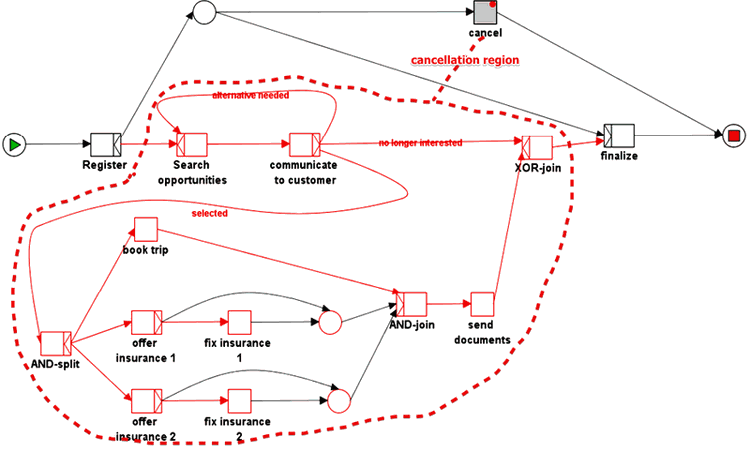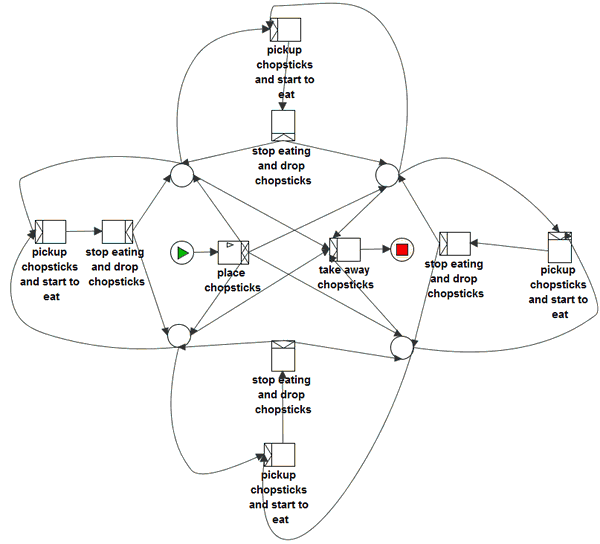YAWL
YAWL is a graphical notation for expressing workflows, similar to Workflow Nets based on Petri Nets, but with more expressive syntax.
- YAWL is based on Workflow Patterns
- but it’s developed in academic environment
It is possible to express the following constructions:
- choices
- timeouts
- etc
Basic Syntax
Syntax in YAWL looks similar to Petri Nets
- but there is syntactic sugar that makes it easier and more expressive
- and there also is some relaxation of the rules

AND
AND-split:
AND-join

- note that the semantics of the AND-join in YAWL is the same:
- both places need to have tokens for $d$ to fire

XOR
XOR-split

- need to put some code to the XOR-split node: so it will decide which way to follow
- (don’t confuse with Deferred Choice)
XOR-join

- semantics is the same: $d$ can fire if there’s a token in either place

Loops
While-loop

- based on the condition in the XOR-split it either continues or stops
- it was not possible to express that in Workflow Nets
Repeat-loop

- until the condition in the XOR-split is not satisfied, $B$ will not be enabled
Start and Stop
There’s also a special notation for start and stop places
Transitions
Transitions in YAWL can be connected directly, without a place within them
- but there still is an implicit invisible place between such transactions

- if there’s a place between transitions, it means that one is done, but the other has not started
Transitions in YAWL are no longer atomic
- in YAWL now you cannot assume that they fire immediately: they may need some time to do the task

- so in essence, one transition in YAWL correspond to two transitions in a Petri Net and one place between them
Exercise

- what are the valid firing sequences? what activities can be performed in parallel?
- first, let’s explicitly show the invisible places and name all the places

- now we can build some kind of a Reachability Graph (here we don’t consider places inside the transactions)
- but in this case, unlike in Petri Nets, firing one transition can lead to several states

- in this example firing $B$ may bring to 3 different states, depending on what arch it will take
- we see that this network in not sound:
- it has no option to complete in several cases
- it has improper termination
- the highlighted edges lead to the final state
- thus the valid firing sequences are:
- $ABCD$
- $ABCEFG$
- $ABCFEG$
- $ABCFEG$
- $ABCCEFG$
- $ABCCFEG$
- note that, for instance, $ABCCEFG$ may correspond to two different paths in the reachability graph
- based on that it’s clear that $E$ and $F$ can run in parallel
Advanced Syntax
Cancellation Regions
OR-Split and OR-Join
OR-Split
OR-split is similar to XOR-split
- but instead of taking one route, it can take many
Example
- suppose we’re buying a flight ticket and offered 2 additional options: hotel and car

- the branches to active depend on what exactly you have selected
- and the OR-split should be programmed to route in the needed directions
- the system can fire many tokens, but there’s one restriction: there must be at least one token
Note that
- OR-split is just syntactic sugar
- it can be expressed with AND-splits and XOR-splits

OR-Join
OR-Join is used to synchronize many incoming branches
It has the “bus driver” semantics
- OR-Join is activated only when all tokens are ready to be consumed
- a bus driver will wait for people to jump in when he sees that people are still coming
We should handle OR-joins
- this semantics can be computationally quite expensive
- some decision properties may suddenly become unavailable
- if complicates the model
Example

- if there are still tokens to arrive, the OR-join will wait for them
- once everybody is ready - it fires
Consider the following net:

- in this example none of the OR-joins can fire
- there hypothetically can be more tokens to arrive
- so they are waiting
- no Option to Complete
Examples

- case (a):
- $C$ is enabled: it’s a XOR join
- and $D$ is enabled: it’s not possible to get a token from another branch
- case (b):
- $C$ is working, but it can be started again: it’s enabled since there’s another token
- $D$ is not enabled: it will be only when $C$ finishes its work
- case (c):
- $A$ is already running
- $C$ is enabled (here it’s the same situation as in the case (a))
- but $D$ is not enabled: there’s in a token inside $A$, which may arrive from the branch below
- case (d):
- $C$ enabled
- but $D$ is not enabled: there’s a token before $C$ that may arrive
Sub-Nets
To increase readability it’s possible to fold some activities to one
- this concept is called a ‘‘sub-net’’

- a subnet must also be a valid net - with its own start and stop places
Data
It is possible to store some variables in the YAWL engine
- to keep the results of execution, etc
Data can be stored at different levels (i.e. scopes)
- process level - global
- case level - related to this particular case
- i.e. data for each case is different
- task level - most local
We don’t need to transfer data from activity to activity
- there’s a single data storage that will keep it

Timers
’'’TODO’’’
Resource Perspective
’'’TODO’’’
YAWL Option to Complete
YAWL’s option to complete is different from the option to complete property of Workflow Nets
YAWL-OTC:
- for every reachable marking $M$ we can reach the final marking $[o]$
- so this is a combination of Option to Complete and Proper Termination
- unfortunately YAWL-OTC is not always decidable, therefore it’s sometimes still better to use the definition of the Option to (improperly) Complete
Examples
Housing Agency Net
Example 2: Travel Agency
To organize a trip
- the customer request is registered
- then an employee looks for opportunities
- the customer is contacted to find out whether he is still interested and whether more alternatives are desired
- if the customer selects a trip, then the trip is booked.
- in parallel (optionally) one or two types of insurance are prepared
- two weeks before the start date the documents are sent to the customer
- it is possible that the customer cancels the trip at any time before the start date

It is also possible to use OR-join for choosing the insurances:
Example 3: Homework Submission
An exercise for modeling from the resource perspective:
Example 4: Four Dining Philosophers
The same net as in Petri Nets:
Links
- http://www.yawlfoundation.org/yawlbook/downloads.html
- http://yawlfoundation.org/yawldocs/GettingStartedWithYAWL.pdf




